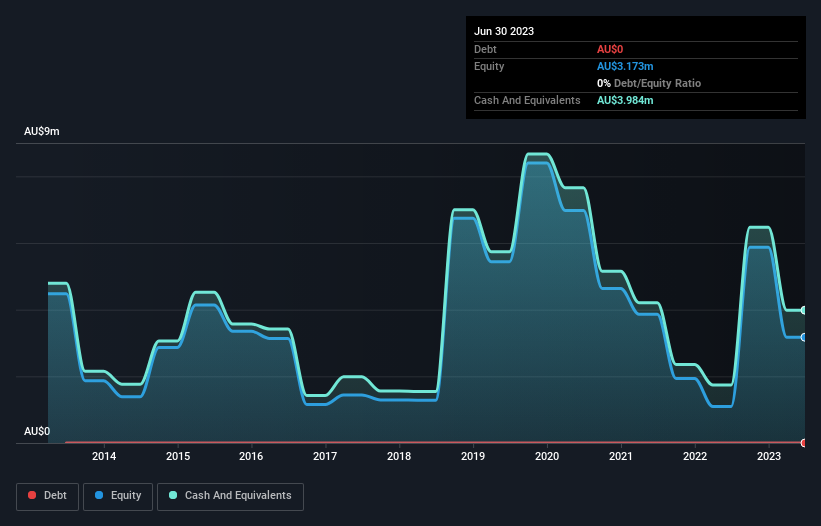Here's Why We're Not Too Worried About Biotron's (ASX:BIT) Cash Burn Situation

Just because a business does not make any money, does not mean that the stock will go down. For example, Biotron (ASX:BIT) shareholders have done very well over the last year, with the share price soaring by 165%. But the harsh reality is that very many loss making companies burn through all their cash and go bankrupt.
In light of its strong share price run, we think now is a good time to investigate how risky Biotron's cash burn is. For the purpose of this article, we'll define cash burn as the amount of cash the company is spending each year to fund its growth (also called its negative free cash flow). First, we'll determine its cash runway by comparing its cash burn with its cash reserves.
Check out our latest analysis for Biotron
How Long Is Biotron's Cash Runway?
A cash runway is defined as the length of time it would take a company to run out of money if it kept spending at its current rate of cash burn. When Biotron last reported its June 2023 balance sheet in August 2023, it had zero debt and cash worth AU$4.0m. In the last year, its cash burn was AU$3.3m. So it had a cash runway of approximately 15 months from June 2023. That's not too bad, but it's fair to say the end of the cash runway is in sight, unless cash burn reduces drastically. You can see how its cash balance has changed over time in the image below.

How Is Biotron's Cash Burn Changing Over Time?
While Biotron did record statutory revenue of AU$1.4m over the last year, it didn't have any revenue from operations. To us, that makes it a pre-revenue company, so we'll look to its cash burn trajectory as an assessment of its cash burn situation. Over the last year its cash burn actually increased by 35%, which suggests that management are increasing investment in future growth, but not too quickly. That's not necessarily a bad thing, but investors should be mindful of the fact that will shorten the cash runway. Admittedly, we're a bit cautious of Biotron due to its lack of significant operating revenues. So we'd generally prefer stocks from this list of stocks that have analysts forecasting growth.
How Hard Would It Be For Biotron To Raise More Cash For Growth?
While Biotron does have a solid cash runway, its cash burn trajectory may have some shareholders thinking ahead to when the company may need to raise more cash. Companies can raise capital through either debt or equity. Many companies end up issuing new shares to fund future growth. We can compare a company's cash burn to its market capitalisation to get a sense for how many new shares a company would have to issue to fund one year's operations.
Biotron's cash burn of AU$3.3m is about 5.3% of its AU$62m market capitalisation. That's a low proportion, so we figure the company would be able to raise more cash to fund growth, with a little dilution, or even to simply borrow some money.
Is Biotron's Cash Burn A Worry?
On this analysis of Biotron's cash burn, we think its cash burn relative to its market cap was reassuring, while its increasing cash burn has us a bit worried. While we're the kind of investors who are always a bit concerned about the risks involved with cash burning companies, the metrics we have discussed in this article leave us relatively comfortable about Biotron's situation. Separately, we looked at different risks affecting the company and spotted 3 warning signs for Biotron (of which 2 shouldn't be ignored!) you should know about.
If you would prefer to check out another company with better fundamentals, then do not miss this free list of interesting companies, that have HIGH return on equity and low debt or this list of stocks which are all forecast to grow.
If you're looking to trade Biotron, open an account with the lowest-cost platform trusted by professionals, Interactive Brokers.
With clients in over 200 countries and territories, and access to 160 markets, IBKR lets you trade stocks, options, futures, forex, bonds and funds from a single integrated account.
Enjoy no hidden fees, no account minimums, and FX conversion rates as low as 0.03%, far better than what most brokers offer.
Sponsored ContentValuation is complex, but we're here to simplify it.
Discover if Biotron might be undervalued or overvalued with our detailed analysis, featuring fair value estimates, potential risks, dividends, insider trades, and its financial condition.
Access Free AnalysisHave feedback on this article? Concerned about the content? Get in touch with us directly. Alternatively, email editorial-team (at) simplywallst.com.
This article by Simply Wall St is general in nature. We provide commentary based on historical data and analyst forecasts only using an unbiased methodology and our articles are not intended to be financial advice. It does not constitute a recommendation to buy or sell any stock, and does not take account of your objectives, or your financial situation. We aim to bring you long-term focused analysis driven by fundamental data. Note that our analysis may not factor in the latest price-sensitive company announcements or qualitative material. Simply Wall St has no position in any stocks mentioned.
About ASX:BIT
Biotron
A biotechnology company, engages in developing and commercializing small molecule products to treat various viral diseases in Australia.
Flawless balance sheet and good value.
Market Insights
Community Narratives



